The fact is, it seems, that the most you can hope is to be a little less, in the end, the creature you were in the beginning, and the middle.
Spoken by Molloy, riding his bicycle – Samuel Beckett, Molloy, 1951
John Grierson’s group of public-information film makers at the Empire Marketing Board – often identified as the acorn from which grew the whole of British documentary film – were scattered when it was closed in 1933. Many went with Grierson himself to the GPO, the Post Office. Edgar Anstey was one of those who made that move, and then moved on.
Anstey eventually became, in 1949, the head of the film unit set up by the British Transport Commission. Under Anstey, British Transport Films, like the GPO before them, and like several private-sector equivalents at firms like Shell, made hundreds of films promoting public transport – including British Railways, nationalised in 1948 and the inland waterways, nationalised in 1947. Their tone, inevitably in the economic hard times after the Second war, was very much ‘make do and mend’ – persuading the public in lots of ways that the long-lasting austerity of the post-war exhaustion was good for the nation. Remember that the good times did not simply magically get switched on after VE day. Food rationing – which we apprehensively wonder about in these days of the coronavirus – did not end until 1954. It is perfectly plausible to argue that prosperity didn’t really return until twenty years after the war ended (and then only for some) – and that the Swinging Sixties was when the nation at last began to let its breath out. Those films were internal propaganda in hard times – to be situated somewhere on a spectrum between the Reithian BBC and Beaverbrook’s Daily Express.
One of these films, made by a team under Anstey, is a relatively well-known and very enjoyable one made by British Transport Films in 1956 called Cyclists’ Special. It gets Tweeted and Instagrammed periodically as somebody new discovers it. You can see it (free, through the good graces of the British Film Institute) here :
Cyclists Special, 1956, via BFI
The premise is simple; the tone is jolly. The idea is that British Railways would tack a few freight wagons adapted to carrying bikes (the adaptation stretched to rubber-covered hooks to hang the machines by their front wheels) on the back of an excursion train from Willesden Junction or Watford to Rugby, thus allowing people to get out of the city and ride loops around such joys as the monument to the battle of Naseby, with cheery stops in the pub on the way. It’s an interesting piece of film history and social history in its own right, and in my view (but I’m very ignorant of film) these public service films are under-appreciated. But that’s not the only reason to bring this particular one to your attention.
I notice the bikes, beautiful and now probably very classic British lightweights for the most part, and I notice the people on them. Those people are rangy and tough, certainly, and their average weight far lower than we’re used to seeing today. But they are also quite a wide cross-section in age: some are young, some much older. Many of them carry cameras, too. The camera and the bike share many things in common, from their nineteenth century origins and mechanical consistency through the years, to the powerful democratising effect they have both had. Although the bikes in the film are lighter than the heavy roadsters many would have used around towns, they have remarkably little special equipment to distinguish them from an ordinary commuter. The cyclists were recruited for the film from among members of the venerable Cyclists’ Touring Club, founded in 1878. There are still occasional CTC badges to be seen on the youth hostels or cafes or pubs they approved, dotted around the country in a manner exactly parallel to the rather more common AA badges that offer assurances for the quality of service in hotels for motorists, for long before the AA, the CTC was a members’ organisation of great reach and importance. It still exists, oversensitively rebranded as Cycling UK to avoid excluding those who take no interest in touring – for the old CTC took the Touring part of their title seriously. They made maps, published routes, they ran meetings which included strenuous gallops of many tens of miles.
This film dates from pretty closely the same time as the Rough-Stuff Fellowship, founded in 1955, which was a sort of offshoot or sub-set of the Cyclists’ Touring Club. It gives you a wonderful chance to see what these people looked like.
The Rough-Stuff Fellowship still exists, a very distinctive (and almost caricaturally British) association of cyclists whose particular relish is to go where it’s not really possible to bicycle at all. While the machines used by the members have changed a little, the spirit has really not. They still like routes arduous to the point of impassibility, and they still share an ethos of non-competition in which brewing mugs of tea in wild locations acquires considerable importance. They make adventures for themselves, and are changed by their adventures. In 2019, The Rough-Stuff Fellowship Archive appeared, a book devoted to them, part tribute, part lifestyle guide. It’s also fully a photographic book, and a very interesting one. This is about that book, and although it’s taken me some words to get here, most of the pictures that follow come from it.


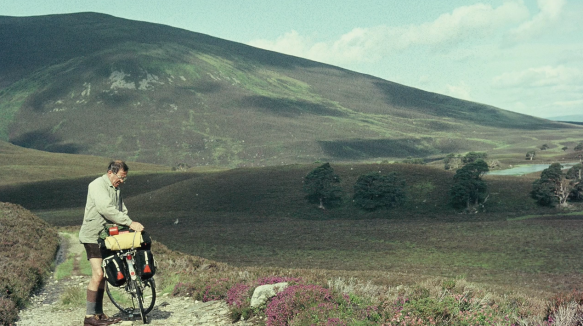
According to Mark Hudson, the archivist of the Rough-Stuff Fellowship, “a gentleman called Bill Paul was inspired by the writings and lantern shows of a chap who went by the name of Wayfarer, a keen advocate of tracks and the lesser trodden path. Bill put out a series of adverts in local and national press to see if there was interest in starting a club for similar minded folk. There was an immediate and positive response. Around 40 people turned up for the inaugural meeting, and quickly the membership grew into the hundreds.” Remember, this is in the mid-1950s, long before the invention of mountain bikes and mountain biking.

Illustration for ‘The Open Road’, Wayfarer’s lecture given under the auspices of the CTC on December 8th 1921 in Liverpool.
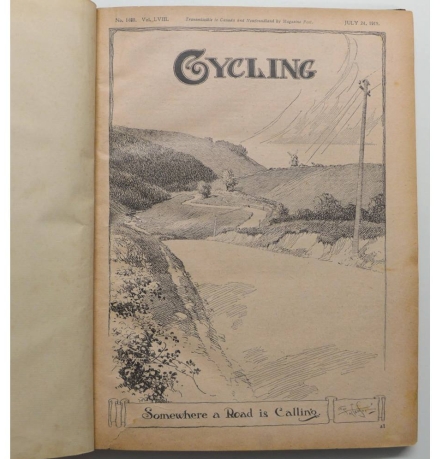
Somewhere a Road is Calling. Frank Patterson cover for Cycling Magazine, 1919

Frank Patterson, Westmorland Wanderings, 1931
The ‘chap’ whose influence they acknowledged was Walter MacGregor Robinson, a Liverpool insurance agent who wrote of riding the mountains of North Wales for Cycling Magazine in the period immediately after the Great War, and whose lectures on cycling were immensely popular. They tapped into something of the same feeling of the greatest of all cycling artists, Frank Patterson, whose illustrations were in the same journal, that an idyll could be found if one put the miles in. In modern terms, no doubt they were right, too. Plainly, for people actually damaged in the war, either in the trenches or at home, or for people whose world-view had been badly shaken up by the post-war world, plain outdoor exercise would have helped recovery, physical or mental.
A much later – and also a hugely popular advocate of bicycling as a refuge of sanity in an otherwise over-hasty, over-consuming world, Richard Ballantine, was to be influenced by precisely the same thinking and always paid his tributes to off-road cycling, to MacGregor, and to Patterson. Richard’s Bicycle Book, as it was called, first published in 1972, was maybe responsible for a similar resurgence in interest in bicycling. And there’ll be another one along soon. Bicycling ‘lost’ a huge battle of public relations to the motor lobby in the early twentieth century, notably in the United States. But its basic attractions, of expanding the human range (and maybe individual freedom) at low cost, of a mechanically extraordinarily effective machine which can go a hundred miles or more on two bananas and a few throatfuls of water, tend to recur in the public imagination every so often.
It is slightly hard to throw one’s mind back. Sometime in the 1990s, perhaps a little earlier, outdoor activity of all kinds became a consumerist arena, and the particular marketing ploy that became its driver was subdivision. It wasn’t enough to have a rucksack, for example. You had to have a bag allegedly specific to your kind of activity. Look in your own cupboards now, if you don’t believe me. You have more rucksacks than you need, maybe several more. Same with sports shoes, which have morphed into a zillion variants, with coats, even with leggings and such apparently sport-indifferent kit. The proliferation of bikes and bike gear, became so absurd that even the shopkeepers could no longer tell you the differences between machines marketed into ever tinier niches. Cyclo-cross? Hard-tail? Oh, no, Madam, you’ll be wanting a gravel bike.
Rough-stuff predates all that. It predates the Rough-Stuff Fellowship, too, come to think of it. There must be many Clarion clubs that cycled rough roads long before the 1950s. The early Tour de France went up goat tracks. Rough-stuff riding involves a degree of hardship, an avoidance of cossetting. It definitely involves no-nonsense knees, of any gender, exposed in any weather. It was something that ‘ordinary’ people did on more-or-less ordinary bikes. It had something of the ethos of the Mass Trespass on Kinder Scout, in 1932, described once by Roy Hattersley, the former Deputy Leader of the Labour Party as “the most successful direct action in British history”. The Mass Trespass formalised the wide popular appeal of rambling over the countryside and led directly, in 1951, to the establishment of the first National Park in the Peak District. That was only a few years before the launch of the Rough-Stuff Fellowship. Rough-stuff was outdoor leisure of a similar kind to rambling, similar to the tough non-pricey sailing that was contrasted to the very different business of ‘yachting’, similar to climbing, even perhaps with something in common with Scouting. It was for working people, whatever their line of work. They made their own entertainment, often around a camp fire. They stayed in Britain, at first, because mass jet-travel had not yet arrived. Rough-stuff riding involved camping, basic cooking, mending one’s own machines. Those riding rough-stuff might well spend a (relative) lot of money on a machine marketed as a tourer by Mercian or by Holdsworth or by Ellis Briggs, or they might even try going up mountains on what was called an Audax bike (there’s the beginning of specialisation for you – it just meant a lighter ‘fast touring’ bike) but it wasn’t really a shopping activity.

The Bertram Dudley Nomad, 84/- in Gaberdine, 116/6 in Poplin
Which is not to assume that hours and hours of highly technical conversation weren’t a part of the joy of the thing: I’m sure they were. The great jacket of those days – or at least the one that all the nostalgia fiends looking back claim was the one – was called a Greenspot Nomad, made by Bertram Dudley of Cleckheaton in Yorkshire. It was made of a tightly woven gaberdine, and apart from pockets designed to hold an Ordnance Survey map and pockets in that position (beloved of cyclists) over your kidneys reachable while riding, it also had a zip that stopped well short of the hem, to allow free movement for thighs pedalling. But look carefully at the pictures in the book and you’ll see as much non-gear as gear. Ordinary flannel shirts, windbreakers, even town shoes of whichever kind worked OK on the bike. Almost all the saddle bags in the pictures are Carradice – also canvas, but much stouter, almost unbending canvas, like something from the heavier end of the sail locker. That’s still made, in Nelson, Lancashire, where CLR James and Learie Constantine played their cricket for a while in the 1930s. But second-hand army stuff was pretty good for a lot of kit. I took a while to work out what the circular brass fitting was that hangs off the top tube of a lot of bikes in the RSF archive book; but the RSF Instagram sorted me out in the end. It’s a Primus stove with a special bike attachment called a Terry clip. As I say, I’m sure gear of all sorts was part of the pleasure; but I don’t think the Rough-Stuff people were particularly worried about shopping. Old and worn and proven seems to have been better than new and not quite tough enough. Look at those people in the film.
Archivist Mark Hudson has got together with writer Max Leonard, founder of a specialist outdoor and cycling publisher called Isola Press, to produce the book (Isola Press, £28.00). Many of the reviews have centred on the eccentricity or quirkiness of the Rough-Stuff people, and there’s something to that. I myself used the word caricatural a few lines ago. Yet I don’t think it’s the caricature that’s the most important thing here. Sure, one can laugh at the stoic qualities displayed – often in the rain. It’s very noticeable that in the whole book there are far more pictures of people pushing bikes than riding them (because if you do choose to ride on narrow tyres on unmade roads there will be many miles that you simply can’t ride.) I enjoy all that a lot: pictures of people pushing bikes through rivers, or lowering them on ropes down cliff faces, or up to the cranks in snow.
If you enjoy that, too, it’s very simple. Buy the book, which is a delight, and follow https://www.instagram.com/rsfarchive/, which is another.
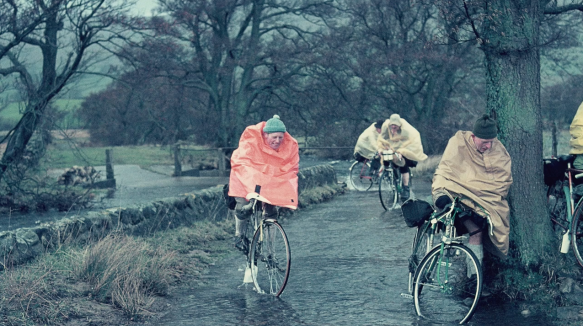
Yorkshire, 1976

This seems strenuous, even by RSF standards

The bicycle may seem ill-adapted to the conditions
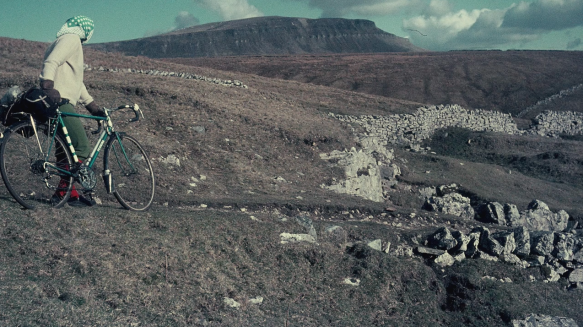

Crossing the Maize Beck, 1955

S. Ireland, 1955. Do notice that those are tandems, which are often fast on a road, but very heavy being pushed uphill.
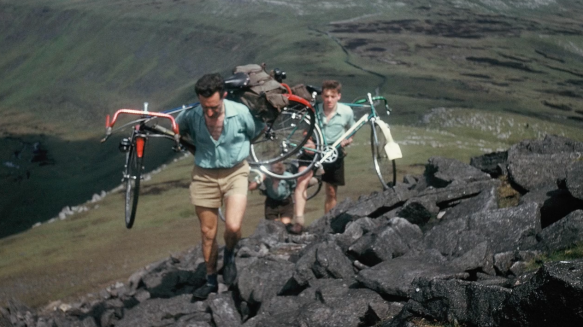
Ingleborough, 1957. It’s like taking an old and favoured but now lame dog for a walk. You carry it almost all the way.

Glen Doll Scotland, 1959. Here is one example of the Terry clamp holding a Primus tank to the top tube.
But there’s another thing.
This is a rather good photographic book. It is proper social history, of an informal kind, certainly, but still … There is a principal author in the person of Bob Harrison, who is credited with the majority of the photographs (and the distinguished outdoor photographer Henry Iddon has supplied new pictures of the archive itself, including views of slides laid out for editing, wooden drawers of miniature plan-chests crammed with 35millimetre slides and so on). This is a wholly respectable, wholly fair exploration of a sub-group through its archive. It gives a plentiful element of context, good original material to study (including much in the way of maps and diaries and reproduced magazine pages that goes far beyond the photographs themselves). It reproduces many photographs which are both crammed with interesting detail and redolent of their time and of the groups they came from. This is, in other words, a book of serious intent which stands mainly on the photographs it brings together, on the context in which they are shown, and on the background furnished with them. Yet it has, as far as I know, made no ripples of any kind in that corner of the world which admires and discusses photobooks.
This seems to me quite a revealing failing. Now, it seems, only those things which are self-consciously ‘fine’ photographs draw the attention of the people self-consciously interested in photography, and a fairly naïve, fairly un-self-conscious collection of pictures like this one simply doesn’t count. Some of the cycling community have taken to this book with curiosity, with an open-minded interest in what it shows and what it reminds us of. It advertises today more than £50,000 on its Kickstarter account, a sum to make green many hundreds of self-publishing photographers scraping about for ways to cover the costs of their hope for an audience. The RSF Archive book makes a wonderful coronavirus book of escapism and absurdity and the possibility of dancing down into the next valley. But it wasn’t conceived as that. It is a proper collection of photographs. There’s honour to the people who did the riding in there, and also honour to those who made and edited the pictures. It does have a jolly tone, certainly, and its premise is not complex. But it’s none the worse for that. It’s also an invitation to re-think, perhaps to a world in which standing around in yellow capes was itself a pleasure. Why does that largely miss the world of photography? Is photography now only to be considered when it’s about previous photographs?

Thrilling stuff, all conveyed in pictures made by cyclists — Bob Harrison and others — who in the midst of strenuous and, I imagine, often frustratingly wet and miserable, conditions hauled out their camera, unclipped the flapping ‘ever-ready’ case, wiped condensation off the lens and viewfinder, guessed the exposure, focussed with a pesky rangefinder or set their d.o.f. scale, and got the shots conscious of not wasting precious 25 or 64 ASA (ISO) Kodachrome, before everybody moved on, then raced them to catch up. You catch the 1950s tone perfectly and top it all with the Molloy quote from Beckett which is itself a raw gem…all round a very enjoyable post written empathetically by someone who’s obviously turned the cranks a few times themselves. It makes me yearn for my old Raleigh. Thank you!
LikeLike
What a wonderful find! The quality of the photographs is amazing.
LikeLiked by 1 person
What a wonderful find!
LikeLike